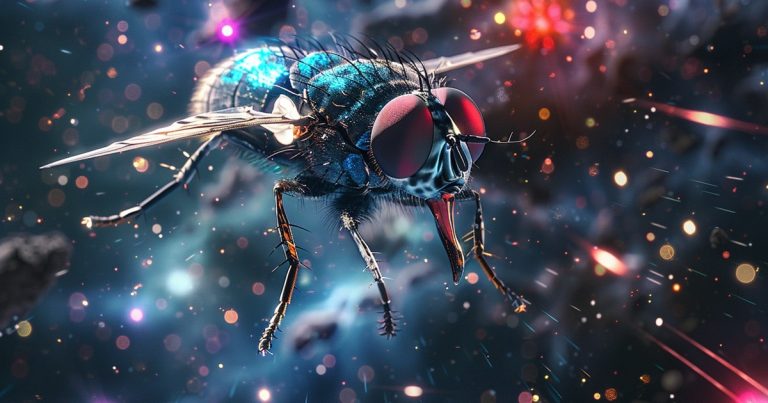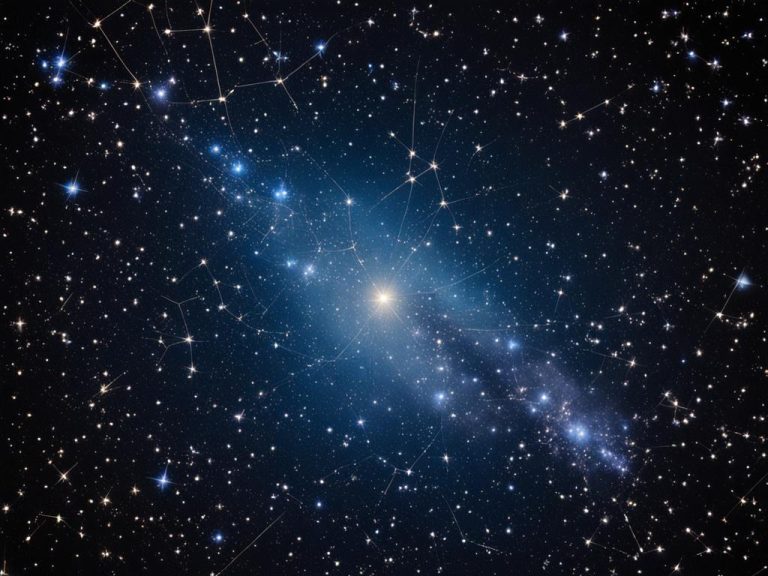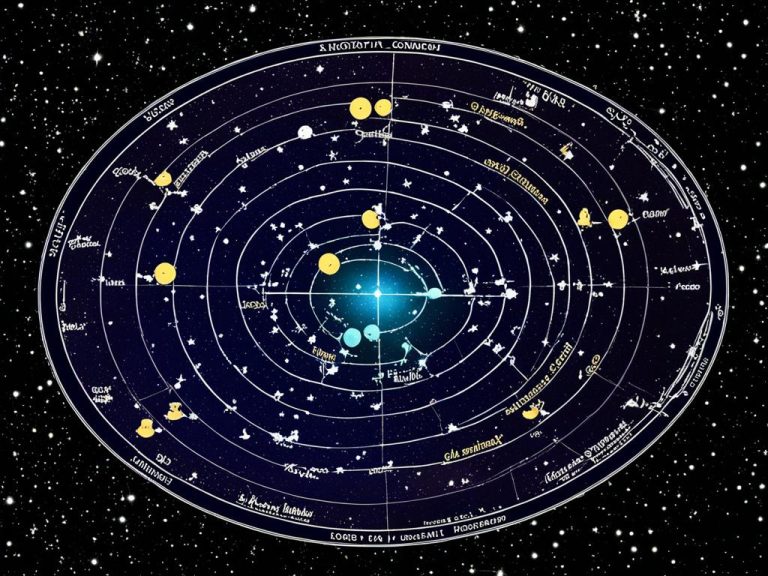Explore the Wonders of Musca Constellation
Modified: July 19, 2024 Author: International Star Registry
Did you know Musca is the smallest constellation in the night sky? This small group of stars amazes astronomers and stargazers. Its unique features and history have caught people’s eyes for many years.
Also called the “fly,” Musca was first seen by Dutch explorers Keyser and de Houtman in the late 16th century. They were on their way to the southern hemisphere. When they shared their discovery, astronomer Petrus Plancius made it official in 1597. He put Musca on celestial globes.
In 1603, Musca became well-known because of Johann Bayer’s work, Uranometria. This work was a big deal at the time. Musca is still a big sight for people in the Southern Hemisphere. It looks the best in May, around 9 p.m.

Key Takeaways:
- Musca is one of the smallest constellations in the night sky.
- It was first observed by Dutch explorers Keyser and de Houtman in the late 16th century.
- Musca was officially recognized by astronomer Petrus Plancius and later included in Uranometria.
- The constellation is best seen in the Southern Hemisphere during the month of May at 9 p.m.
- Stay tuned to learn more about the origin, bright stars, variable stars, and stellar associations within the Musca constellation.
Origin of Musca Constellation
The constellation Musca is known as the Southern Fly. It has a rich history. It all started with Dutch explorers in the late 16th century in the Southern Hemisphere. They noted the stars of the region.
A Dutch cartographer named Petrus Plancius used their data to create the Musca constellation in 1597. This marked its spot among the stars.
Not until 1603 did it appear in Johann Bayer’s Uranometria. Bayer was a lawyer and astronomer from Germany. He included it in his star atlas, giving Musca official status.
Musca was first called Apis, which means bee. But to avoid confusion, it was later changed to Musca Australis, or “Southern Fly.” It’s the only constellation officially dedicated to an insect.
Musca became central in southern skies because of its unique shape. Over time, it became a key point on maps and atlases. This helped both astronomers and sky watchers.
Learning about Musca’s origin shows us the hard work of ancient astronomers. People like Plancius, Keyser, Houtman, and Bayer laid the foundation. Their efforts inspire us to explore the universe today.
Bright Stars in Musca Constellation
Within the Musca constellation, many stars shine brightly. They display the beauty and variety of the night sky. Let’s look at some of the brightest stars here.
Alpha Muscae
Alpha Muscae stands out as the top star in Musca. It has a brightness that catches everyone’s eye. This blue-white star is at type B2IV-V.
Beta Muscae
In Musca, there’s Beta Muscae, a fascinating pair of stars. These two stars are both blue-white. They orbit each other, making a great scene for anyone looking up.
Gamma Muscae
Gamma Muscae adds to Musca’s brilliance with its blue-white light. This star of type B5V is truly luminous.
Delta Muscae
Delta Muscae is a stand-out orange giant in the Musca cluster. It’s a big star of type K2III. Seen with the naked eye, it shows a beautiful orange color.
Epsilon Muscae
Epsilon Muscae is our last star in this tour. It is a red giant, twinkling in the sky. As an M5III star, it changes slightly in brightness, making it more enchanting.
These bright stars make the Musca constellation a magical place. They fill us with awe and wonder. Musca is indeed a wonderful constellation to look at.
Variable Stars and Star Systems in Musca Constellation
We explore the Musca constellation and find an amazing range of stars and systems. These include Theta Muscae, R Muscae, and S Muscae. They each have special features and a unique placement in the sky.
Theta Muscae: The Triple Star System
Theta Muscae stands out with its trio of stars. It draws the eyes of astronomers and fans of the night sky. This group has a Wolf-Rayet star that shines brightly and loses a lot of mass.
These stars move around in a beautiful show. Their dance shows us a lot about how stars interact. It’s a highlight in Musca’s part of the night.
R Muscae and S Muscae: Classical Cepheid Variables
R Muscae and S Muscae bring more interest to Musca. They are known as classical Cepheids. They get brighter and dimmer in a regular pattern.
R Muscae’s brightness changes every 7.5 days. S Muscae’s changes take about 9.66 days. This helps us measure how far away these stars are. It also helps us learn more about space.

Looking at the stars in Musca is like watching a show that never ends. Theta Muscae’s triple stars, and R and S Muscae’s bright pulse, show the stars’ beauty. They make us wonder about the huge and complex universe.
Stellar Associations in Musca Constellation
In the big Musca constellation, many stars belong to groups. They move together across the Milky Way. One famous group is the Scorpius–Centaurus association, filled with bright blue-white stars. These stars move and look alike, showing they share a common story.
The Scorpius-Centaurus association covers a big area in the south sky and has multiple parts. Musca is lucky to have stars from the Lower Centaurus Crux group. These stars are alike in age and what they’re made of. They likely began together because of the same reason in space.
Stellar groups in Musca, like the Scorpius-Centaurus association and Lower Centaurus Crux, teach us a lot. Studying these groups helps astronomers learn about star birth and how the universe forms.
Want to know more about the Musca constellation and its stars? Check out Wikipedia, Constellation Guide, and The Planets websites.
History and Mythology of Musca Constellation
The Musca constellation has a unique history but lacks a direct mythological story. It started as a fly on a star map made by Petrus Plancius in the late 1500s. Later, a mistake made Johann Bayer call it a bee in his 1603 book.
Musca has varied names in stories and scientific books over years. Apis, which is Latin for “bee,” and Musca Australis, which means “Southern Fly,” are a couple of its names. Musca stands as the only insect constellation.
Despite the absence of detailed myths, Musca’s rich history and names still captivate astronomers and lovers of the night sky.
The Significance of Nicknames in Folklore
- Petrus Plancius: Plancius drew the first fly shape on a star chart, shaping how Musca is known today.
- Johann Bayer: He thought Musca was a bee, not a fly, in his work from 1603.
Musca’s different names, like Apis and Musca Australis, show its place in ancient stories and cultures. Even without many myths, Musca’s various names add to its importance and keep people interested.
Importance and Cultural Significance of Constellations
Constellations are key in guiding travelers for centuries. They help sailors find their way across oceans and explorers on land. Besides this, they’re a big part of our culture and source of creativity. People from ancient times told stories about them, stories that still captivate us today.
One such constellation is Musca, known as the Fly. It’s not large, spanning only 138 square degrees, but it’s memorable. Musca appears in the southern skies, adding to the beauty of our night view.
Musca stands out because of its shape. It looks like an insect, which is unique among constellations. This unusual form has sparked the imagination of many, from poets to scientists.
According to ancient tales, Musca holds a special meaning. Its name comes from an old word meaning gnat or fly. This link to small insects can be seen in many folklore stories.
But Musca is more than myths and symbols. It also reminds us of ancient times and our connection to the universe. It’s a symbol of our shared history and our search for meaning.
To show respect for constellations like Musca, people can name stars. By naming a star through International Star Registry, you keep a piece of the universe forever. It’s a great way to mark special moments in life.
To know more about Musca and its story, visit this link, this link, and this link.
Astronomical Groupings and Star Clusters in Constellations
Constellations are a window into the vastness of space, showing us more than just beauty. They hold star clusters, galaxies, nebulae, black holes, and meteor showers. These wonders teach us about stars’ lives and how the universe is organized.
Star clusters are among the most stunning things in space. The Milky Way has over 150 of these globular clusters. Each one has millions of stars, packed closely together like a city in the sky.
About a third of these clusters are found near our galaxy’s center, looking like mini satellite systems. They can be as massive as a million suns and stretch across hundreds of light-years. Some, like Omega Centauri, are huge, making them easy to spot with the naked eye.
In these clusters, the light isn’t spread evenly. In M3, for example, 90 percent of the light stays within just 100 light-years. This makes their centers much brighter than our neighborhood in space. While we only have about one star in 300 cubic light-years here, these clusters have two stars in the same space.
The stars in these clusters also differ in metal content. Stars near us are richer in metals than those in the cluster’s central parts. This is because the stars near the center formed earlier, when the universe had less metal.
Variable stars, like RR Lyrae, are key to understanding star clusters. These stars change in brightness, offering clues about the clusters’ composition and age.
Now, the age of these clusters is truly astonishing. They are almost as old as time itself, averaging 14 billion years. This makes them windows to the early universe, with ages ranging from 12 to 16 billion years.
But star clusters are not the only interesting things in space. Galaxies have their own star clusters, each with thousands of stars. These clusters help us understand how galaxies, like the Andromeda Galaxy, form and evolve.
By studying these cosmic features, we learn more about space and our place in it. They awe us, but also challenge us to explore and understand the universe.
For more information on star clusters, visit the following resources:
Exploring the Orion Constellation
The Orion constellation is easy to spot in the night sky. It gets its name from a Greek hunter. It stands out with its three-star belt. This area has many bright stars, two of the brightest being Betelgeuse and Rigel.
The Orion Nebula is in Orion’s sword. It’s a place where new stars form. This area is amazing to see, even without a telescope.
For centuries, Orion has fascinated people worldwide. The ancient Egyptians tied it to their god Osiris. Greeks talked about a skillful hunter named Orion. Its position also helped sailors and travelers find their way.
People can see Orion from both the north and south. This makes it great for everyone interested in the stars. The winter is the best time to view it. Whether you’re into stargazing or not, Orion is truly wonderful to explore.
The Importance of Ursa Major and Ursa Minor Constellations
Did you know, the Ursa Major and Ursa Minor constellations are loved by many who look at the stars? They are also called the Big Dipper and the Little Dipper. For hundreds of years, they have guided people, been symbols of cultures, and excited those who study space.
Ursa Major is big and bright, with a distinctive shape that looks like a “Big Dipper” and a “Plough.” Its stars Alioth, Dubhe, and Alkaid shine beautifully. It has many bright stars and serves as a signpost in the sky.
It’s not just bright stars in Ursa Major. There are also amazing sights like Messier 81 and Messier 101, beautiful galaxies. With 223 visible stars and 514 deep sky objects, it’s a treasure trove for star lovers.
Then, there’s Ursa Minor, known as the Little Dipper, smaller but also with a rich history. It’s home to Polaris, the North Star. Other stars are Baekdu, Kochab, Pherkad, and Yildun.
Kochab, a giant star, is 130.9 light years away. Pherkad, a bright A-type star, is 487 light years away. Yildun and Zeta Ursae Minoris are some of the other fascinating stars they hold.
Many cultures have stories about Ursa Major and Ursa Minor. They’ve become well-known shapes in the sky over time. Exploring their stories and science can be very interesting.
For more about Ursa Major and Ursa Minor, check out places like The Sky Live and Constellation Guide. They have lots of cool info.

Looking at Ursa Major and Ursa Minor, we see more than shapes. They show us the universe’s vast beauty. They tie us to our past and fill us with wonder.
Conclusion
Looking at the Musca Constellation and other stars is a magical journey. It grabs our attention and makes us dream. These star patterns take us back to old tales and customs. They show us how tiny we are in the big universe.
The Musca Constellation shines with bright stars in lovely shapes. It reminds us of the many secrets just waiting to be found. It shows the beauty and mystery above us.
For anyone who loves stars or just enjoys looking at them, it’s special. Staying up late to watch the stars brings joy to our hearts. We learn how amazing the universe really is. It makes us want to know more than what’s on Earth.
So, get your telescope, wait for a clear night, and start your star journey. Watch the Musca Constellation and all the stars. Feel the night sky’s amazing spirit. Let it spark your curiosity and joy.
FAQ
What is the Musca Constellation?
The “fly” constellation is small and in the deep south sky. It appeared first in 1597 on a globe. Johann Bayer featured it in his work in 1603.
What are some of the bright stars in the Musca Constellation?
Its bright stars are Alpha Muscae, Beta, Gamma, Delta, and Epsilon Muscae.
Does the Musca Constellation have any mythology associated with it?
It doesn’t have a set story. However, it’s been called different names and was once seen as a bee by Johann Bayer.
What is the cultural significance of constellations?
They’ve guided navigation for years. Plus, they’ve sparked myths and ancient tales.
Source Links
- Musca – https://en.wikipedia.org/wiki/Musca
- Constellations – https://www.starregistry.com/constellation-name/
- Musca – https://www.universetoday.com/22006/musca/
